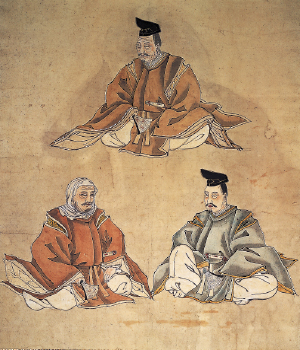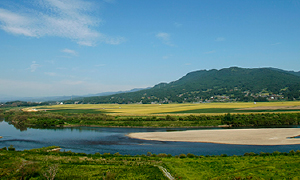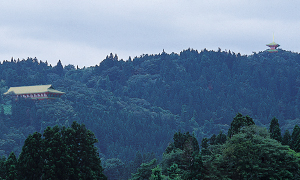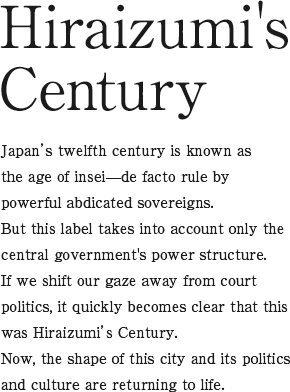
Michinoku—Toward Independence

Take out a map of Japan. In southern Fukushima, right near the border with Tochigi, is a city called Shirakawa. Since olden times, the area north of the barrier that once stood here has been known as Mutsu. It is also called, Michinoku, “beyond the road,” because it was located past the end of the Eastern Mountain Route (Tōsandō). For reference, it’s about 550km from Shirakawa to Aomori according to the JR timetable. Considering that the distance from Aomori to Tokyo to Kagoshima is 2240km, this is about one fourth of the entire length of Japan (before the addition of Hokkaido and Okinawa).
Mutsu, or Ōshū, wasn’t just big—it was Japan’s only gold producing region. Another one of the region’s famous products was its prized horses. Fine paper and lacquer, indispensable to the court culture in Kyoto, were also produced here. Mutsu also traded with the northern regions of Hokkaido and Sakhalin. For all of these reasons and more, when it came to Mutsu the court was primarily concerned with safe delivery of tribute and taxes, which included the area’s horses and gold.
Even modern-day Chiba was referred to by the people of the capital as, “farther beyond even the end of the eastern roads.” Michinoku was Japan’s ultima Thule—a frightening Other on the doorstep made all the more threatening by its wealth. The court expended nearly endless resources to tame and conquer this “barbarian” land.
Hiraizumi is situated in just about the center of old Mutsu, at the confluence of the Koromogawa and Kitakami Rivers. The lands beyond the barrier here (Koromogawa no Seki) were known as Oku Rokugun (the Six Back Districts); this road station effectively demarcated the border between imperial lands and the realm of Tohoku’s indigenous people, the Emishi. In the eleventh century, the Emishi were controlled by the powerful Abe family.
When Yoriyoshi, a warrior-noble of the powerful Minamoto clan, was appointed peacekeeping general and governor of Mutsu in 1053, he attempted to contain the Abe. Armed conflict soon broke out between the two sides, as the Abe leader Yoritoki closed down the barrier and resisted Yoriyoshi’s efforts to extend his control into the Back Districts. This fighting left the court understandably concerned. This incident is known in history as the Former Nine Years’ War, though it actually lasted a dozen years (1051-62). The upshot of this bloody struggle was Abe defeat. A noble and local administrator named Fujiwara no Tsunekiyo sided with the Abe in this dispute. He had married an Abe woman, and it was their child who would found the Ōshū Fujiwara dynasty. His name was Kiyohira.
Hiraizumi—A Buddhist Capital

In the wake of the Former Nine Years’ War, it was not Yoriyoshi who occupied the conquered Abe lands but rather the Kiyohara, a rival local clan that had sided with the Minamoto forces and been largely responsible for their victory. Kiyohira’s mother was remarried into the Kiyohara clan and his life spared. From the sensitive age of seven, he was forced to live as the adopted son of his defeated father’s enemies. Two decades later, when Kiyohira was 28, internal friction within the Kiyohara erupted into violence. Newly appointed Mutsu governor Minamoto no Yoshiie entered the conflict, which has come to be known as the Later Three Years’ War (1083-1087).
Yoshiie sided with the eventual victor in this family feud, but without permission from the court. Thus, rather than being rewarded for restoring peace to the region he was removed from his post and forced to leave Mutsu altogether. The last man standing in Ōshū was Kiyohira, heir to a bizarre triumvirate of family legacies: Abe, Fujiwara, and Kiyohara. By no design of his own, Kiyohira came to sit atop the power structure of Mutsu.
Kiyohira was originally based in the Esashi area of present-day Ōshū City. The decision to move his base of operations to Hiraizumi, with its flatter, more open topography, is indicative of Kiyohira’s desire to graduate from lord of the Six Back Districts to ruler of all of Michinoku.
Kiyohira understood that the universalism of Buddhist doctrine and faith was the only way to bring together people tired of war and left nervous and unsure by a crumbling governmental system and social instability.
The first of Kiyohira’s great projects upon finding himself ruler of Michinoku was to Kiyohira establish umbrella reliquaries at 106m intervals along the great road that ran from the barrier at Shirakawa to the port of Sotogahama (Aomori). On the face of each one was an image of Amida (Amitābha), the Buddha of Infinite Light and lord of the Buddhist Pure Land. Travelers from the south would follow these reliquaries to Chūsonji, Kiyohira’s great temple complex. Near the peak of the temple hill was a hall called Tahōtō, which, drawing from a motif in the Lotus Sutra, enshrined seated statues of Tahō (Prabhūtaratna) and Shaka (Śākyamuni). A two-storied hall called Daichōjuin contained nine standing Amidas, a powerful array of Buddhist statues designed to facilitate the rebirth of all people in Paradise. The temple’s Shaka Hall contained more than one hundred golden Shaka statues. Kiyohira also built temples and halls in each and every town and village in Michinoku, and set aside fields for them.
Kiyohira’s vision was to transform the entirety of Michinoku into a Buddhist realm that included every single living thing in the area. This was not just Kiyohira’s way of placating the spirits of the many lost in fruitless conflict, but also the foundation of his dream of Ōshū independence.
Hiraizumi—History's Stage


